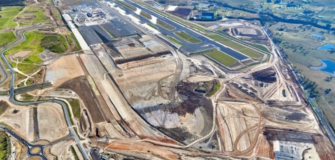Coates launches BIM for temporary works
Martin Sinclair Oct 29

Coates Engineering Solutions has launched a suite of BIM-compatible CAD models for its most popular temporary works products. Digital models of Coates’ award-winning Quadshore Prop System; Universal Prop System; Dono Brace and Tilt Prop range are available free of charge to all customers from early October 2024.
“While Building Information Modelling (BIM) has become widely adopted in architectural and structural design, the uptake of BIM has been comparatively slow for temporary works. Customers are now requesting digital models of our products, and we’re increasingly seeing BIM integration specified as a supplier requirement when tendering for Tier 1 contracts,” says David Dragicevich, National Technical Engineering Manager at Coates.
“By creating BIM-compatible models of our products we are enabling project owners and their engineering teams to integrate temporary works into their designs. We’re also helping customers to tender competitively and to harness the value of more informed, efficient and cost-effective solutions.”
What is BIM and how is it used? The role of BIM in the construction industry, and the benefits of integrating BIM into the design and installation of temporary works.
Coates’ website explains in detail the huge value of BIM to the construction industry. Major construction and infrastructure projects require contributions from many different design and construction disciplines, making them extremely complex to deliver. For more than two decades, BIM has been used to reduce this complexity, integrating data from a variety of sources to create 3D virtual building models.
“BIM helps people to visualise and understand the many different properties and schedules that relate to designing, constructing, operating and demolishing buildings,” explains David.
Across the project lifecycle, BIM can aggregate diverse data on the physical and functional characteristics of a building, including its geometry, material properties, lighting, heating, ventilation, energy and acoustic requirements, and construction schedules.

Coates’ new BIM models allow design teams to integrate our temporary works equipment into their designs
Benefits of BIM for temporary works
Integrating BIM into temporary works leads to safer, more efficient construction processes and improved project outcomes for the industry. Here are the key benefits of using BIM for temporary works:
Enhanced collaboration among stakeholders
With numerous stakeholders in any construction project, various design disciplines need to integrate or overlap with each other. Having a trustworthy and easily accessible single source of information for all project stakeholders will prevent unnecessary mistakes, mitigate conflict, reduce the need for reworks, and minimise costly delays.
Informed decision making
BIM is a powerful tool for informing the design and construction of temporary works. “Not everyone can read technical drawings, but the visualisation that BIM offers affords everyone a good understanding of the temporary works design and its wider context,” says David. “By centralising all project data, BIM ensures everyone in the design team can make decisions based on current, reliable and highly contextual data. It also highlights where these designs overlap, and where there’s potential for conflict.”
Design, efficiency, safety and cost effectiveness
According to David, BIM enhances the accuracy and cost-effectiveness of temporary works design and improves the safety and efficiency of installation. “If we attend site for installation based on our designs, we often find some unexpected conditions on site that require adjustments to be made,” he says. “BIM creates a holistic view that gives you a much better understanding of the environment you are designing for, and that you will be working in, before you get to site.”
Modelling the built environment in three dimensions makes it much faster and easier to translate temporary works designs into different drawings with great detail and rich building information. “BIM brings more detail, context and understanding to the design of temporary works, without necessarily costing you more in design time or labour to build,” says David. “BIM also allows a broader range of factors to be considered and design efficiencies to be achieved outside of the scope of temporary works.”
“For example, some structural components may not be needed, or they could be replaced with fewer or lower capacity struts. Or there may be areas where greater support is needed for the safety and integrity of the solution,” David continues. “Extending BIM to include temporary works empowers project teams to find these efficiencies. It also informs design accommodations like access requirements and the type of machinery that can be moved into and used in the space.”
Enhanced project management and documentation
The better the project documentation, the more accurate the basis for cost estimation.
“Construction project delays are often caused by inaccurate or insufficient project documentation, miscommunication and other clashes that occur during design. BIM provides a way to address many of these design phase challenges,” says David. “Improving the efficiency of design and project documentation helps to automate these processes, as with highly accurate and comprehensive 3D models to work from, you no longer need to reinvent the wheel every time changes need to be made.”
Contact Coates Engineering Solutions to learn how BIM for temporary works can improve the design and implementation of your next construction project.










